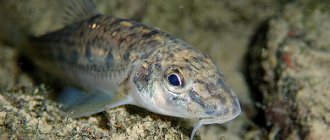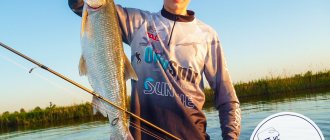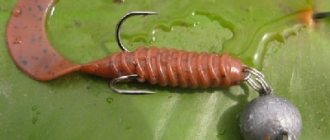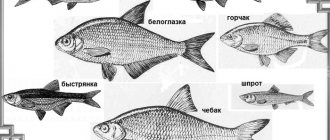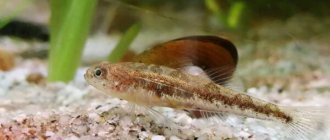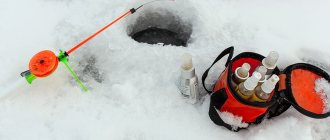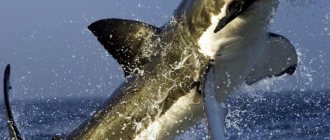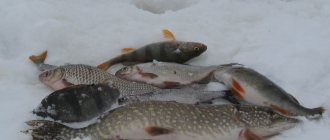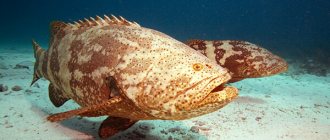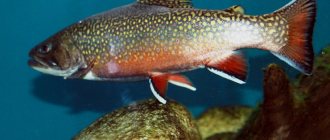Sterlet is a valuable commercial fish. Belongs to a small species of the sturgeon family, ray-finned class. Sterlet does not have scales; they are replaced by bony scutes (another name for bugs), arranged longitudinally in 5 rows. One is located in the middle of the back, the other two stretch along the sides, and two pass near the stomach (you can see the photo of the sterlet in more detail below). Between them the body is densely covered with small bony scutes or remains bald. The dorsal bugs close tightly to each other. The body with convex sides is highly elongated.
On top, the sterlet is dark gray or with a brown tint, the ventral part is dirty white. The fins are gray, the dorsal is located near the tail. The head has a flat forehead, smoothly turning into a long nose. The shape of the nose is usually sharp, but blunt-nosed individuals are also found. Gill rakers are simple, numbering 16-21 on one arch. The mouth is small, transverse, the lower lip bifurcates in the middle. On the sides of the mouth there are short antennae, hanging down. The sterlet has no teeth and grinds food using small graters in its mouth.
Sterlet spawning
Sexual maturity in males occurs after 4-5 years of life, and in females at 6-7 years. Sterlet spawning usually begins in April, when the water warms up to +9-10 C. In the northern regions, reproduction does not start until May. Males are the first to rush upstream, choosing areas in the beds of wide rivers or in the backwaters of the spring flood. Females join when the water warms up to +12-13 C. Spawning takes place at a depth of 8-15 meters, in areas with a rocky and uneven bottom.
The eggs stick tightly to stones, gravel or underwater cartilage and are not washed away even by strong currents. The dark gray or black eggs have a sticky structure and are usually 2-3 mm in diameter and weigh 7-8 mg. The larva develops in 5-9 days, and at first the sterlet feeds on the granules of its yolk sac. After 2 weeks, the natural sac is depleted, and the sterlet begins to obtain food on its own.
One female is capable of laying more than 120 thousand eggs, the number depends on the size and age of the fish. Sterlet caviar is smaller than that of other sturgeon representatives. Spawning lasts about two weeks, after which the sterlet leaves the riverbeds and enters the floodplains, where it settles in reeds and backwaters to feed. Some adult individuals do not reproduce in every season.
Artificial breeding and cultivation
Sterlet aquaculture is widely developed in special cage farms, which consist of a number of pools or are located in open and enclosed reservoirs. The main condition for successful sturgeon keeping is good aeration, which allows you to saturate the water with oxygen to a level of 5 mg/l or more. It is necessary to maintain the optimal temperature regime of the environment +18-24°C, since in very cool water bodies (below +1-2°C) fish begin to die en masse.
Advanced cage farms use special equipment that allows not only to settle, enrich with oxygen, disinfect and, if necessary, heat water, but also to organize its mechanical and biological treatment for reuse and cost reduction. The greatest difficulties in artificial breeding of sterlet are associated with accustoming the fish to feeding on compound feed. With the correct organization of the process, in just 9-10 months you can “translate” a tiny fry weighing 5-7 g into a sought-after product category with a net weight of 400-500 g.
To learn more:
Is a bream a small bream or not?

Sterlet habitats
Sterlet is predominantly a river fish and is less common in deep lakes. The main habitats of the sterlet are in the fresh waters of European Russia, including Siberia and tributaries of the Yenisei. Fish are numerous in the Kama, on the Catherine Canal, in the Northern Dvina basin. The Volga basins (in its lower and middle reaches) are famous for a large number of sterlet; they are also found in Lakes Onega and Lake Ladoga.
Avoids salty water, preferring to live in river basins of the following seas:
- White;
- Barentsev;
- Karsky;
- Caspian;
- Azovsky.

In the Dnieper basins, a valuable specimen is found in the Smolensk and Bryansk regions, swimming in the clear waters of the Danube, Prut and Bug. In the Black Sea basin, sterlet appears rarely and in small schools; every year there are fewer and fewer fish there, which signals pollution of water bodies.
Sterlet lifestyle
Sterlet fish is found in clean, deep-water rivers with a sandy, pebble or rocky bottom. Small rivers with muddy bottoms, mud and stagnant water are avoided. Salted water is also avoided. The fish is a semi-anadromous species, but is not suitable for long swims; it stays near the very bottom, coming to the surface only during the spawning period or for prey.
The sterlet’s lifestyle is collective; the fish gather in small schools according to age and rarely move alone. The winter season for sterlet ends as soon as the river loses its ice. The start time of spring activity depends on the region - from mid-March to April. Before spawning, the fish feeds heavily, and after spawning it comes closer to the surface to regain strength. In summer, sterlet spends the day in the depths, and in the evenings it swims to areas of the coast where there is a lot of vegetation. The sharp-nosed sterlet is more active than the blunt-nosed sterlet, which prefers depth.
The sterlet spends the night off the coast, catching insects. She has the ability to roll over onto her back and grab food falling from the branches with her mouth. With the onset of autumn, the fish goes to the bottom, looking for the deepest and warmest areas, where it buries itself in the sand or hides under stones. She spends her winter time in this position. It prefers holes at a depth of 20-25 m, where it is packed in dense rows. Sterlet hibernation begins early - already at the end of September the fish loses activity and lies down, spending the winter without food.
Reproduction
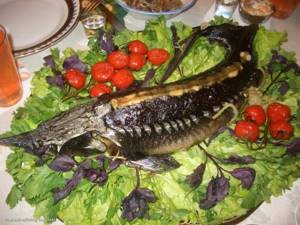
The sterlet spawning period lasts from mid-April to the first days of June. The fish finds spawning places in the upper reaches of rivers. Each female can lay from 15 to 50 thousand eggs. The temperature should be 12-17 degrees Celsius.
The fish prefers deep places with soil consisting of pebbles or stones. The caviar is so sticky that it sticks perfectly to the rocky bottom, despite the fast current. Current plays a positive role in the development of sterlet eggs. Due to constant exposure to water, the eggs are not covered in silt and do not die.
Egg development occurs quickly. On the fourth day after spawning, the first sterlets hatch. After the yolk sac resolves, after about 14 days, the young begin to feed on their own.
If you find an error, please select a piece of text and press Ctrl+Enter.
Life cycle of a sterlet
The first weeks of life, the fry hide in underwater cartilage or under stones and do not leave the birthplace. They feed on juices that are sucked from the natural bladder. When they grow up, they form flocks and begin to rise to the surface in search of food. In two years of life, the sterlet grows up to 20 cm; after five years it is considered an adult.
The life cycle of a sterlet is 27-30 years, but this is short compared to other sturgeons, which are considered long-lived and live up to 75-80 years. Sterlet is capable of interbreeding with other species of its fellow sturgeons, in particular with beluga. The result was a unique hybrid - bester.
Related species
Despite the fairly large diversity of representatives of the family (dozens of types of sturgeon, stellate sturgeon, thorn, kaluga), all species are biologically very close and allow the formation of unique hybrids.
In 1952, a bester was bred in the USSR, whose name consists of the first syllables of the name of the “parents” - the largest generic taxon of Beluga (Huso huso) and the smallest - Sterlet.
This fish is characterized by tolerance to salt water (up to 18%) and a sharp contrast between the gray-brown or brown back and light belly. The original hybrid incorporated the accelerated growth of beluga and the rapid maturation of sterlet. The maximum weight of a bester reaches 28-30 kg with a body length of 170-180 cm. But these figures can be doubled subject to further crossing with the pure form of Huso huso - the beluga bester. In the basins of the Irtysh, Ob, Yenisei, Angara, Sayano-Shushenskoye and Krasnoyarsk reservoirs, a special subspecies of sturgeon lives - the Siberian sterlet (Acipenser ruthenus marsiglii). This taxon differs from the basic form by late maturation, lighter color and the ability to gain weight over 20 kg.
To learn more:
Subtleties of eel fishing: places and gear
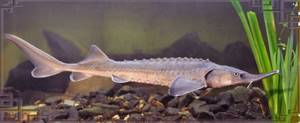
Sterlet nutrition
Sterlet is a predatory fish and prefers animal food. The sterlet's diet consists of eating living organisms on the surface and underwater inhabitants in the depths. The fry feed on the smallest crustaceans (brine shrimp, daphnia, etc.), mollusks, larvae, and a variety of plankton. As they grow older, the diet includes larger foods - worms, beetles, crustaceans, small fish and eggs of other fish (he does not disdain his own).
In summer, sterlet eats insects: mosquitoes, grasshoppers, midges, butterflies. The sterlet can deftly grab prey on the fly, jumping vertically out of the water. In addition to its long nose, it also has antennae that are responsible for searching for food, with which the sterlet catches the swarming of the prey at the bottom.
Methods of catching sterlet
To catch a sterlet, you need to choose the right place. The location of the fish depends on the season. If the river is deep, the prey comes close to the shore; when the water level drops, it stays near deep holes. The sterlet chooses areas where the river flow weakens and borders on standing water - many insects accumulate there. The bite is usually expected in the late evening and before dawn, but experienced anglers note the unpredictability of the fish.
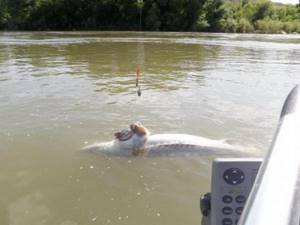
A common tackle for catching sterlet is a donka, that is, a bottom fishing rod. Use carp rods, rubber bands or donkeys. It is better to take an inertial reel, which will allow you to make long casts. A fishing line with a diameter of 0.3 mm is suitable, the color does not matter - the sterlet is not very shy. The sinker should be flat and heavy (60-80 g), so it will not be carried away by the current. It is better to take removable leashes 30-40 mm long so that they can be quickly replaced if necessary. Two leashes are knitted 50 cm in front of the sinker. The hook needs to be sharp and strong, No. 7 is optimal. It is easier to get a hook with a long shank from the mouth of a sterlet.
When using a float rod, the rod is strong but long so that it is convenient to fish. The leash is thin, which will prevent it from getting tangled with the fishing line. Sharp and thin hooks are suitable; it is better to attach two at once. Sterlet is also caught with a spinning rod, choosing a medium or high-class rod. The reel should be of the inertial type, the sinker, fishing line and hooks should be taken as for the bottom one, taking into account the depth of the river and the features of the bottom topography.
Sterlet fishing is permitted only with a license, otherwise you can get a fine for sterlet if you catch it illegally. The fishing period is from July to September 1. Fishing for specimens smaller than 30 cm is prohibited. After fishing, the license must be closed, otherwise the catch cannot be transported.
{banner_vnutri-kontenta-3}
Description and features
The underwater world is very rich in inhabitants. There are several tens of thousands of fish species alone there. But there are some of them who received the honorary title of “royal”. These include the sturgeon fish sterlet . But why and for what did she deserve such a title? This is what we have to figure out.

If you believe the tales of fishermen of the past, then such underwater creatures were not small. Some of them, becoming the pride of the lucky ones who caught them, reached almost two meters in length, and their carcass weighed about 16 kg. It may very well be that all this is fiction, or perhaps times have simply changed.
But the average sterlet of our day is much more compact, especially the males, which, as a rule, are smaller and thinner than the more impressive female representatives. The usual size of such fish is now about half a meter, and the weight does not exceed 2 kg. Moreover, adult specimens weighing 300 g and a size not exceeding 20 cm should be considered quite common.
The appearance features of these underwater inhabitants are unusual and differ from the shape and structure of most fish in many interesting details. The sloping, elongated, cone-shaped front part of the sterlet ends in a slightly curved upward, pointed, elongated nose. Tapering towards the end, its length is almost comparable to the head of the fish itself.
But in some cases it is not very prominent, rounded. Beneath it one can see a mustache falling like a fringe. And the expressiveness of the muzzle is added by small eyes located on both sides.
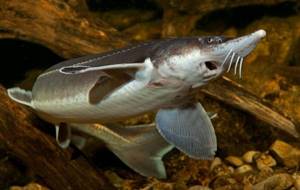
The mouth is like a slit cut from the bottom of the snout; its lower lip is forked, which is an important characteristic feature of these creatures. Their tail has the shape of a triangle cut in two, with the upper part of its fin protruding more than the lower.
Another interesting feature of such a fish is the absence of scales on its long body with rather large, curly gray fins, that is, in the usual sense for us. It is replaced by bone shields. The largest of them are arranged in longitudinal rows.
The largest ones, equipped with spines and having the appearance of a continuous wave-like crest, replace the dorsal fins of these wonderful creatures. A number of shields are also visible on both sides. And two more border the belly, the main area of which is unprotected and vulnerable.
In those parts of the fish’s body where rows of large scutes are absent, only small bony plates cover the skin, and sometimes it is completely bare. In short, these creatures look really unusual. But no matter how much you describe it, it is impossible to imagine their appearance unless you look at a photo of a sterlet .

For the most part, the color of the back of such fish is brown with a grayish or darker tint, and the belly is light with a yellowish tint. But depending on the individual characteristics and habitat, the colors vary. There are specimens the color of rain-soaked asphalt or gray-yellow, sometimes a little lighter.
Lures for sterlet
Sterlet is not lured; baits of animal origin are used. The most popular are medium-sized worms and small shrimp. Maggot is often used as an addition to any worms - dung, rain and crawling.
Also suitable as bait:
- small butterflies;
- beetle larvae;
- bloodworm;
- fry of other fish.
The size of the sterlet bait should not exceed 5 cm; a cautious prey will simply bypass a large bait.
How to clean sterlet
Many people wonder: how to clean sterlet? If the fish is alive, it should be placed in the freezer for 1 hour.
You need to cut the sterlet with a sharp knife as follows:
- rinse the fish and pour boiling water over it to get rid of mucus;
- cut off all the bugs on the back, working from the tail to the head;
- scrape off the skin between the scutes;
- cut off the tail and fins. When cooking whole, the gills should be removed.
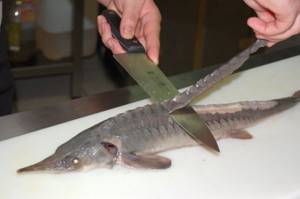
Cut the belly lengthwise down the center and remove the insides. Proceed carefully, without touching the gallbladder. If you come across caviar, it must be washed well, freed from the film and salted.
To remove the vizier: make one transverse cut near the head, and the second near the tail, cutting the ridge of the fish. Pick up the white cord with tweezers or a hook and carefully pull it out without damaging the walls of the vizig (it is poisonous inside). If it is not removed, the meat will become hazardous to health.

